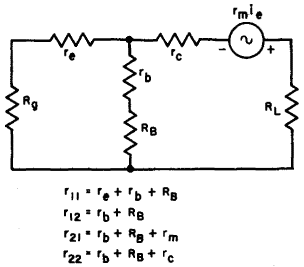| Transistor Basics is a free introductory textbook on transistors and their basic applications. See the editorial for more information.... |

|

Home  Transistor Oscillators Transistor Oscillators  Negative-Resistance Oscillators Negative-Resistance Oscillators  Conditions for Oscillation Conditions for Oscillation |
||||
| See also: Negative Resistance and Transistor Stability | ||||






|
||||
|
Conditions for OscillationAuthor: Leonard Krugman
Fig. 6-5. Basic resistance controlled negative resistance circuit. The preceding paragraphs indicate that transistor oscillators can be designed as equivalents for all the known types of vacuum-tube oscillators that use an external feedback path. In addition, the unique property of a transistor that furnishes current gain can also be used to design many other novel types of oscillators.
In general, external resistance can be added to any of the three electrode leads, as illustrated in Fig. 6-5. Substituting the transistor parameter values into equation 6-1 results in: (re + rb + RB + Rg) (RL + rb + RB + rc) - (rb + RB)(rb + RB + rm) < 0 Neglecting re and rb as compared to RB, rc, and rm, this becomes: (RB + Rg) (RL + RB + rc) - RB (RB + rm)< 0 and multiplying out RBRL + RB2 + RBrc + RgRL + RgRB + Rgrc - RB2 - RBrm < 0 which becomes: Rg(RL + rc) + RB(RL + Rg) - RB (rm - rc) < 0 Notice that when rm is less than rc (as in the case of the junction transistor) , the condition for oscillation cannot be satisfied. This re-emphasizes the fact that negative-resistance oscillators can only be designed using the point-contact transistor. Notice also in this equation that if both RL and rg are small compared to the value of (rm - rc), the conditional equation is primarily controlled by the value of RB. The higher the value of RB, the more definite the instability. Furthermore, as the external collector and emitter resistances are increased in value, a higher resistance of RB is required to assure circuit oscillation. The control of oscillation in negative-resistance transistor oscillators, then, is determined by the following three factors, either separately or in combination: the external resistance of the emitter lead (a low value favors oscillation), the external resistance of the base lead (a high value favors oscillation), and the external resistance of the collector lead (a low value favors oscillation).
|
||||
Home  Transistor Oscillators Transistor Oscillators  Negative-Resistance Oscillators Negative-Resistance Oscillators  Conditions for Oscillation Conditions for Oscillation |
||||
Last Update: 2010-11-17


